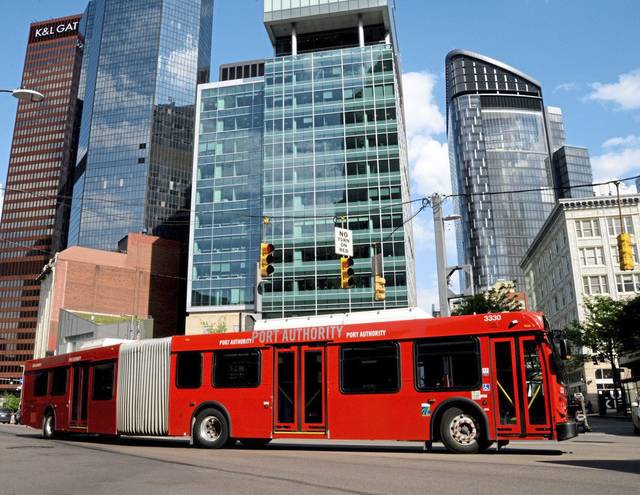https://staging.triblive.com/local/pittsburgh-allegheny/port-authority-buses-use-lasers-to-track-bus-crowding-shares-data-with-riders/
Port Authority buses use lasers to track bus crowding, shares data with riders

Port Authority of Allegheny County just made it easier for riders to know exactly how packed a bus is at any given minute, day or night — and it’s using invisible sensors to do so.
The real-time bus crowding data is accessible through Port Authority’s TrueTime data service available online and via mobile apps. It’s possible through a combination of infrared sensor equipment installed on all buses and a newly available data-sharing tool.
A set of sensors not visible to the human eye tracks every passenger who boards or steps off a bus, Port Authority spokesman Adam Brandolph explained.
“Each bus is equipped with invisible lasers that break one way or another that tell us how many people get on or off each bus,” Brandolph said.
The sensors actually have been doing so for years, and feeding data to Port Authority for internal tracking and management purposes, Brandolph said.
An expanding digital data-sharing partnership now gives the transit agency the ability to share the crowding updates with everyone.
Using Port Authority’s TrueTime tool, riders can determine which routes are overcrowded alongside information about estimated arrivals and delays. The tool also can send notifications about specific routes via text message to riders who request them.
Port Authority tracks buses whose seats fill to capacity on a regular basis, Brandolph said.
The agency defines an overcrowded bus as one where every seat is full during off-peak hours, or 120% full — standing room only — during rush hours. Peak hours across all routes are 6 to 9 a.m. and 4 to 6 p.m.
“The rates depend greatly on the route,” Brandolph said.
The Alle-Kiski Valley’s Route 1 (Freeport Road), which runs from Tarentum to Pittsburgh, was overcrowded on only about 1% of all trips in 2018, Port Authority’s annual report shows.
In comparison, the busiest route is 61C, which was crowded on 17% of trips the same year. It runs from McKeesport to Homestead, then winds through Oakland to its final stop near Point State Park in Downtown Pittsburgh.
“Crowding continues to be a problem on select routes, and Port Authority continues to prioritize reducing crowding to manageable levels wherever possible given labor force and availability of vehicles,” the agency’s annual report said.
Rounding out the most crowded routes countywide:
• P1/East Busway, filled to capacity on 15% of trips in 2018.
• G31/Bridgeville Flyer, 13%.
• 61D/Murray Downtown via Oakland, 12%.
• 71B/Highland Park and 71C/Point Breeze, 11% each.
The agency has a 700-bus fleet.
Most of them — 584 buses — are 40 feet long with about 40 seats. They’re considered overcrowded when all 40 seats are full during off-peak hours, or rush hours when eight or more people on board are standing.
Port Authority’s 35-foot buses have about 30 seats, and the 60-foot double buses seat up to 60.
In 2018, a total of 6.5% of trips were considered crowded, a 9% increase from the previous year. More than half of crowded routes happen during morning and evening rush hours on weekdays.
Copyright ©2025— Trib Total Media, LLC (TribLIVE.com)
